When we think of cauliflower, the typical white variety usually comes to mind. But did you know that there is also green cauliflower? Yes, you read that right! Green cauliflower is a lesser-known member of the cruciferous family and offers a delightful twist to our usual culinary experiences.
Green cauliflower not only adds a pop of vibrant color to your plate but also provides a variety of health benefits. It is rich in vitamins, minerals, and antioxidants, making it a powerhouse of essential nutrients. This amazing vegetable is not only low in calories but also high in dietary fiber, which promotes digestion and helps maintain a healthy weight.
But that’s not all! Green cauliflower is also known for its high antioxidant content, which can help protect the body against harmful free radicals and reduce the risk of chronic diseases.
Key Takeaways:
- Green cauliflower is a unique vegetable that offers vibrant color and a delightful twist to your dishes.
- It is rich in nutrients, low in calories, and high in fiber and antioxidants.
- Adding green cauliflower to your diet can promote digestion, support weight management, and provide protection against chronic diseases.
- Get ready to explore the world of green cauliflower and make your meals not only delicious but also nutritious.
- Stay tuned to learn more about the benefits of growing green cauliflower at home and how to incorporate it into your garden.
The Benefits of Growing Green Cauliflower at Home
Cultivating green cauliflower at home provides numerous benefits. It allows you to have access to fresh and organic produce right from your garden. By growing cauliflower using organic methods, you avoid harmful chemicals and pesticides, making it healthier for you and the environment.
Growing your own vegetables also provides a sense of satisfaction and connection with nature. It’s rewarding to see the fruits (or veggies!) of your labor flourish from seedlings to mature plants. Plus, it’s a great way to get some fresh air and exercise while tending to your garden.
When you grow green cauliflower at home, you have the opportunity to experiment with different varieties and flavors that may not be readily available in grocery stores. Whether you prefer mild, nutty, or slightly spicy flavors, there’s a cauliflower variety to suit your taste buds.
Not to mention, green cauliflower adds a vibrant pop of color to your plate, making your dishes visually appealing. From vibrant lime-green Romanesco cauliflower to rich purple heads of Graffiti cauliflower, these colorful varieties can elevate the presentation of your meals.
So why not take advantage of the benefits of growing green cauliflower at home? Enjoy fresh, organic produce, connect with nature, and explore a variety of flavors right from your own garden!
Popular Varieties of Green Cauliflower
When it comes to green cauliflower, there are several popular varieties to choose from, each with its own unique flavor profile and appearance. Adding variety to your meals has never been easier with these vibrant options:
Snowball Cauliflower
Snowball cauliflower is a classic variety that is known for its large, white heads. This variety is incredibly versatile and can be enjoyed in a variety of dishes, from soups and stir-fries to roasted cauliflower steaks. Its mild flavor and tender texture make it a favorite among cauliflower enthusiasts.
Cheddar Cauliflower
For a burst of color and added nutritional benefits, cheddar cauliflower is the way to go. This vibrant orange variety is not only visually appealing but is also rich in beta-carotene, a powerful antioxidant. Its sweet and slightly nutty flavor adds a delightful twist to any recipe.
Graffiti Cauliflower
For a visually stunning addition to your plate, look no further than graffiti cauliflower. This variety features striking purple heads that are sure to catch the eye. Its vibrant color is not the only thing that sets it apart, as graffiti cauliflower also boasts a slightly sweeter and milder flavor compared to traditional white cauliflower.
Romanesco Cauliflower
Romanesco cauliflower is truly a unique variety that will impress both visually and gastronomically. Its beautiful lime-green hue and captivating fractal-like heads make it a conversation starter at any meal. With a delicate and nutty flavor, romanesco cauliflower adds a special touch to salads, roasted vegetable dishes, or simply enjoyed raw.
Whether you prefer the classic snowball cauliflower, the vibrant cheddar cauliflower, the visually stunning graffiti cauliflower, or the unique romanesco cauliflower, there is a green cauliflower variety to suit every taste and culinary adventure.
Growing Conditions for Green Cauliflower
To ensure successful growth of green cauliflower, it is essential to provide the right growing conditions. Here are the key factors you need to consider:
Sunlight
Green cauliflower requires at least 6 hours of direct sunlight per day. Choose a spot in your garden that receives ample sunlight to promote healthy growth and development.
Soil
The soil for green cauliflower should be well-drained and rich in organic matter. Ensure that the soil is loose and crumbly, allowing for proper root development. Avoid heavy clay soils that retain excessive moisture, as they can lead to root rot.
Temperature
Green cauliflower prefers cool temperatures and can be sensitive to extreme heat or frost. Maintain a temperature range of 60-70°F (15-21°C) for optimal growth. Provide shade or insulation during extremely hot or cold periods to protect the plants.
Spacing
Proper spacing between green cauliflower plants is crucial for adequate air circulation and healthy growth. Allow a spacing of 18-24 inches (45-60 cm) between plants. This ensures that each plant has enough space to spread out and receive sufficient nutrients and sunlight.
With the right growing conditions, green cauliflower plants can thrive and produce beautiful, nutritious heads. Pay attention to sunlight, soil, temperature, and spacing to create an optimal environment for your plants.
| Growing Condition | Optimal Range |
|---|---|
| Sunlight | At least 6 hours of direct sunlight per day |
| Soil | Well-drained, rich in organic matter |
| Temperature | 60-70°F (15-21°C) |
| Spacing | 18-24 inches (45-60 cm) |
Note: The table above summarizes the optimal growing conditions for green cauliflower.
” Providing the right growing conditions is key to success. Pay attention to sunlight, soil, temperature, and spacing to create an optimal environment for green cauliflower plants.”
Starting Green Cauliflower: Seeds or Transplants
When it comes to starting your green cauliflower journey, you have two options: seeds or transplants. Both methods have their advantages and it’s up to you to decide which one suits your gardening preferences and timeline.
Starting from Seeds:
By starting your green cauliflower from seeds, you have complete control over the entire growth process, from germination to maturity. It allows you to experience the joy of nurturing your plants right from the beginning.
The key steps for starting green cauliflower from seeds:
- Sow the cauliflower seeds indoors in seed trays or pots.
- Ensure the seeds are planted at the recommended depth, typically about ¼ to ½ inch deep.
- Keep the soil consistently moist but not waterlogged for optimal germination.
- Provide warmth and adequate light for the seeds to sprout.
- Once the seedlings are about 4-6 weeks old and have developed a few sets of true leaves, they are ready to be transplanted outdoors.
Starting from seeds allows you to witness the entire lifecycle of your green cauliflower plants. It’s a rewarding experience, especially for those who enjoy tending to their crops from the very beginning.
Using Transplants:
If you’re looking to save time and get a head start on your green cauliflower journey, using transplants is a great option. Transplants are cauliflowers that have already germinated and developed into young plants, ready for planting in your garden.
The steps for using transplants to start your green cauliflower:
- Purchase healthy green cauliflower transplants from a reputable nursery or greenhouse.
- Choose transplants that are free from diseases and pests.
- Prepare the planting site in your garden by amending the soil and ensuring it’s well-drained and fertile.
- Dig holes that are slightly larger than the root ball of the transplant.
- Place the transplant into the hole, making sure the crown is level with the soil surface.
- Backfill the hole with soil, gently firming it around the base of the plant.
Using transplants gives your green cauliflower a head start, allowing them to grow and mature faster. It’s a convenient method for those who want to enjoy homegrown cauliflower without waiting for the seeds to germinate and establish themselves.
Ultimately, whether you choose to start your green cauliflower from seeds or transplants, the key is to provide them with the right growing conditions, care, and attention they need to thrive.
Now that you have an understanding of both methods, it’s time to make a decision based on your gardening preferences and the available growing season. Whichever method you choose, the end result will be delicious, homegrown green cauliflower that you can enjoy in a variety of delectable dishes.
Planting Green Cauliflower
When it’s time to plant your green cauliflower, choosing the right location plays a crucial role in its growth and development. Select a spot in your garden that receives full sun exposure. This ensures that the plants receive at least 6 hours of direct sunlight, which is essential for their photosynthesis process. Sunlight exposure promotes healthy growth and the development of vibrant green heads.
Next, consider the spacing between your cauliflower plants. They need sufficient room to spread out and grow properly. Allow for approximately 18-24 inches of spacing between each plant. This spacing provides adequate air circulation, preventing overcrowding and reducing the risk of fungal diseases.
Proper soil preparation is vital for the success of your green cauliflower. Start by incorporating organic matter into the soil, such as compost or well-rotted manure. This improves the soil’s drainage and nutrient content, providing the cauliflower with the necessary elements for healthy growth.
When you’re ready to plant, dig holes that are slightly larger than the root ball of your cauliflower transplants or seedlings. Make sure to place the plant’s crown level with the soil surface, allowing it to grow and develop properly. Gently firm the soil around the base of the plant to ensure stability.
Here is a table summarizing the key steps for planting green cauliflower:
| Planting Green Cauliflower |
|---|
| Choose a location with full sun exposure |
| Provide 18-24 inches of spacing between plants |
| Prepare the soil by incorporating organic matter |
| Dig holes slightly larger than the root ball |
| Place the transplant or seedling with the crown level with the soil surface |
| Firm the soil gently around the base of the plant |
Following these planting techniques will help establish a strong foundation for your green cauliflower plants, setting them up for success as they continue to grow and thrive.
Caring for Green Cauliflower Plants
When it comes to caring for your green cauliflower plants, there are a few key factors to keep in mind: watering, preventing pests and diseases. By paying attention to these important aspects, you can ensure that your green cauliflower grows strong and healthy.
Watering:
Consistent moisture is essential for the proper growth of green cauliflower plants. It’s important to water them deeply and evenly to promote robust development. Avoid shallow, frequent watering, as this can result in weak root systems and hinder the plant’s ability to absorb nutrients. Aim to provide about 1-1.5 inches of water per week, monitoring the moisture levels of the soil.
Preventing Pests and Diseases:
Protecting your green cauliflower plants from pests and diseases is crucial for their well-being. One effective method is to use lightweight fabric covers to shield the plants from harmful insects and potential diseases. Additionally, introducing beneficial insects like ladybugs and lacewings can help control pests naturally, reducing the need for chemical pesticides.
Pro Tip: Encouraging biodiversity in your garden by planting flowers and herbs can attract beneficial insects that prey on common cauliflower pests like cabbage worms, aphids, and flea beetles.
Regular monitoring is essential in identifying signs of pests or diseases. By catching and addressing these issues early on, you can prevent their spread and protect your green cauliflower plants.
To further illustrate the importance of consistent care, here is a table summarizing the watering, pest prevention, and disease management practices:
| Aspect | Best Practices |
|---|---|
| Watering | Water deeply and evenly, avoiding shallow, frequent watering. Provide about 1-1.5 inches of water per week, monitoring soil moisture levels. |
| Pest Prevention | Use lightweight fabric covers to protect plants from pests. Encourage beneficial insects like ladybugs and lacewings. |
| Disease Management | Regularly monitor plants for signs of pests and diseases. Take appropriate measures for prevention and control. |
By following these care guidelines, you can provide optimal conditions for your green cauliflower plants, ensuring their health and productivity.
Harvesting Green Cauliflower
When it comes to harvesting green cauliflower, timing is key. Green cauliflower is ready to be harvested when the heads are compact, firm, and have turned a crisp white color. To determine the maturity of the cauliflower, gently press the head with your fingers. If it feels solid and dense, it’s a good indication that the cauliflower is ready for harvest.
The ideal head size for green cauliflower is around 6-8 inches in diameter. At this size, the heads are at their peak flavor and texture. To harvest the cauliflower, use a sharp knife or garden shears to cut the heads at the base, leaving about an inch of stem attached. It’s important to leave some leaves around the heads to protect them during storage.
| Harvesting Green Cauliflower |
|---|
After harvesting, it’s crucial to store green cauliflower properly to maintain its freshness and quality. For short-term storage, place the heads in a perforated plastic bag and store them in the refrigerator. Green cauliflower can last up to a week when stored this way.
If you’re looking for long-term storage options, you can also freeze or pickle the heads. To freeze the cauliflower, cut the heads into bite-sized pieces and blanch them in boiling water for a few minutes. Then, drain and plunge the cauliflower into ice water to stop the cooking process. Pack the blanched cauliflower into airtight freezer bags or containers and store them in the freezer for up to 12 months.
Alternatively, you can pickle the heads for a tangy and flavorful treat. Chop the cauliflower into florets and place them in sterilized jars. Prepare a pickling brine using vinegar, water, salt, and your choice of spices and herbs. Pour the brine over the cauliflower florets, ensuring they are fully submerged. Seal the jars tightly and refrigerate for at least a week before enjoying the pickled cauliflower.
Common Problems and Solutions for Green Cauliflower
While green cauliflower is a versatile and rewarding vegetable to grow, it can encounter a few common problems. By being aware of these issues and implementing the right solutions, you can ensure a successful harvest. Let’s explore the main challenges you may face and how to address them:
1. Premature Flowering Due to Warm Temperatures
Green cauliflower is sensitive to warm temperatures, which can cause the plants to prematurely flower instead of forming compact heads. To prevent this issue, it’s crucial to grow green cauliflower in cooler conditions. Choose a planting location that provides partial shade during the hottest parts of the day, such as planting near taller plants or using shade cloth if needed.
2. Infestations of Cabbage Worms
Cabbage worms are common pests that can wreak havoc on green cauliflower plants. These green caterpillars can quickly defoliate your plants, leading to stunted growth and reduced harvest. To protect your plants from cabbage worms, consider using physical barriers like fabric covers or floating row covers. These covers will help prevent the adult butterflies from laying their eggs on the plants, effectively reducing the infestation.
3. Nutrient Deficiencies, including a Lack of Nitrogen
Green cauliflower plants require an adequate supply of nutrients to thrive and develop healthy heads. One common nutrient deficiency is a lack of nitrogen, which can result in stunted growth and pale, yellowing leaves. To address this issue, it’s essential to provide supplemental nitrogen to your plants. You can achieve this by incorporating high-nitrogen fertilizers, such as organic fertilizers rich in nitrogen or using worm poop, into the soil during planting or as a top dressing during the growing season.
By taking proactive measures to address these common problems, you can ensure that your green cauliflower plants grow vigorously and produce a bountiful harvest. Now, let’s move on to exploring the benefits of companion planting and the health advantages of including green cauliflower in your diet.
Companion Planting and Health Benefits of Green Cauliflower
When it comes to growing green cauliflower, companion plants play a crucial role in enhancing its flavor and protecting it from pests. By carefully selecting the right companions, you can create a harmonious garden ecosystem that benefits both the cauliflower and the surrounding plants. Some ideal companion plants for green cauliflower include bush beans, beets, carrots, onions, peas, potatoes, spinach, and tomatoes.
These companion plants not only improve the flavor of green cauliflower but also assist in deterring pests that can damage the delicate heads. Their presence acts as a natural form of pest control, reducing the need for chemical pesticides. By interplanting these vegetables, you can create a diverse and vibrant garden that thrives together.
Aside from their valuable role in companion planting, green cauliflower also offers significant health benefits. It contains compounds such as indole-3-carbinol and sulforaphane, which have been linked to cancer-fighting properties. Research suggests that these compounds may help inhibit the growth of cancer cells and reduce the risk of certain types of cancer.
In addition to its cancer-fighting potential, green cauliflower can also contribute to heart health. It is rich in antioxidants and fiber, which have been shown to reduce the risk of heart disease. Including green cauliflower in your diet can help maintain healthy cholesterol levels, lower blood pressure, and support overall cardiovascular wellness.
Furthermore, green cauliflower is beneficial for immunity. It contains essential vitamins and minerals, including vitamin C and manganese, which support a robust immune system. By incorporating green cauliflower into your meals, you can help strengthen your body’s defense against infections and diseases.
To fully enjoy the companion planting benefits and health advantages of green cauliflower, ensure you provide favorable growing conditions and maintain proper care throughout its growth cycle. By doing so, you can experience the joy of cultivating this distinct vegetable while reaping its enticing flavor and healthful rewards.
Tips and Tricks for Growing Green Cauliflower
When it comes to successful growth of green cauliflower, there are a few tips and tricks to keep in mind. By following these guidelines, you’ll have thriving cauliflower plants in no time.
Temperature Control
To ensure optimal growth, it’s important to control the temperature of your green cauliflower plants. Extreme heat or cold can negatively impact their development. During periods of intense heat, provide shade or insulation to protect the plants. Similarly, during cold spells, ensure they are shielded from frost by covering them with a cloth or plastic sheet.
Necessary Nutrients
Proper nutrition is key to the successful growth of green cauliflower plants. Ensure that your plants receive the necessary nutrients by using fertilizers or organic materials that are rich in nitrogen. This will promote healthy leaf and head development. Regularly monitor the nutrient levels in the soil and make adjustments as needed to provide optimal growing conditions. Remember, a well-nourished plant is a happy plant!
Pest and Disease Prevention
To prevent pests and diseases from damaging your green cauliflower plants, it’s important to be vigilant and proactive. Regularly inspect your plants for signs of pests such as cabbage worms, aphids, or flea beetles. Implement appropriate measures for prevention and control, such as using organic insecticides or introducing beneficial insects that feed on pests. By staying ahead of potential issues, you’ll ensure the continued health and growth of your cauliflower crop.
Patience is Key
Lastly, patience is a virtue when it comes to growing cauliflower. It takes time for the plants to reach maturity and develop the beautiful, compact heads that we love. Be patient and consistent in your care routine, providing the necessary water, nutrients, and attention. Before you know it, you’ll be rewarded with a bountiful harvest of delicious and nutritious green cauliflower.
| Tips for Growing Green Cauliflower |
|---|
| Control the temperature to protect plants from extreme heat or cold |
| Ensure plants receive necessary nutrients rich in nitrogen |
| Monitor for pests and diseases and take appropriate prevention and control measures |
| Exercise patience and provide consistent care for optimal growth |
By following these tips and tricks, you’ll be well on your way to a successful green cauliflower harvest. The combination of temperature control, necessary nutrients, pest prevention, and patience will set you up for a rewarding and bountiful harvest of this unique and nutritious vegetable.
Conclusion
Green cauliflower is a unique and nutritious vegetable that provides a multitude of benefits. Growing it at home not only allows you to enjoy the freshness and organic nature of your own produce but also gives you the opportunity to explore various varieties and strengthen your bond with nature. In this comprehensive green cauliflower guide, I have shared valuable gardening tips and tricks to ensure successful growth.
By incorporating green cauliflower into your diet, you can unlock its incredible health benefits. It is rich in antioxidants and fiber, making it a valuable addition to a healthy eating plan. The cauliflower’s cancer-fighting properties, particularly with compounds like indole-3-carbinol and sulforaphane, have been widely recognized. Additionally, its immune-boosting effects can help bolster your overall well-being.
Take the first step towards a greener and healthier lifestyle by starting your own green cauliflower garden today. Follow the guidance provided here, experiment with different varieties, and enjoy the rewards of this eco-friendly veggie. From fresh and flavorful meals to the satisfaction of growing your own food, green cauliflower has something special to offer. Happy gardening!

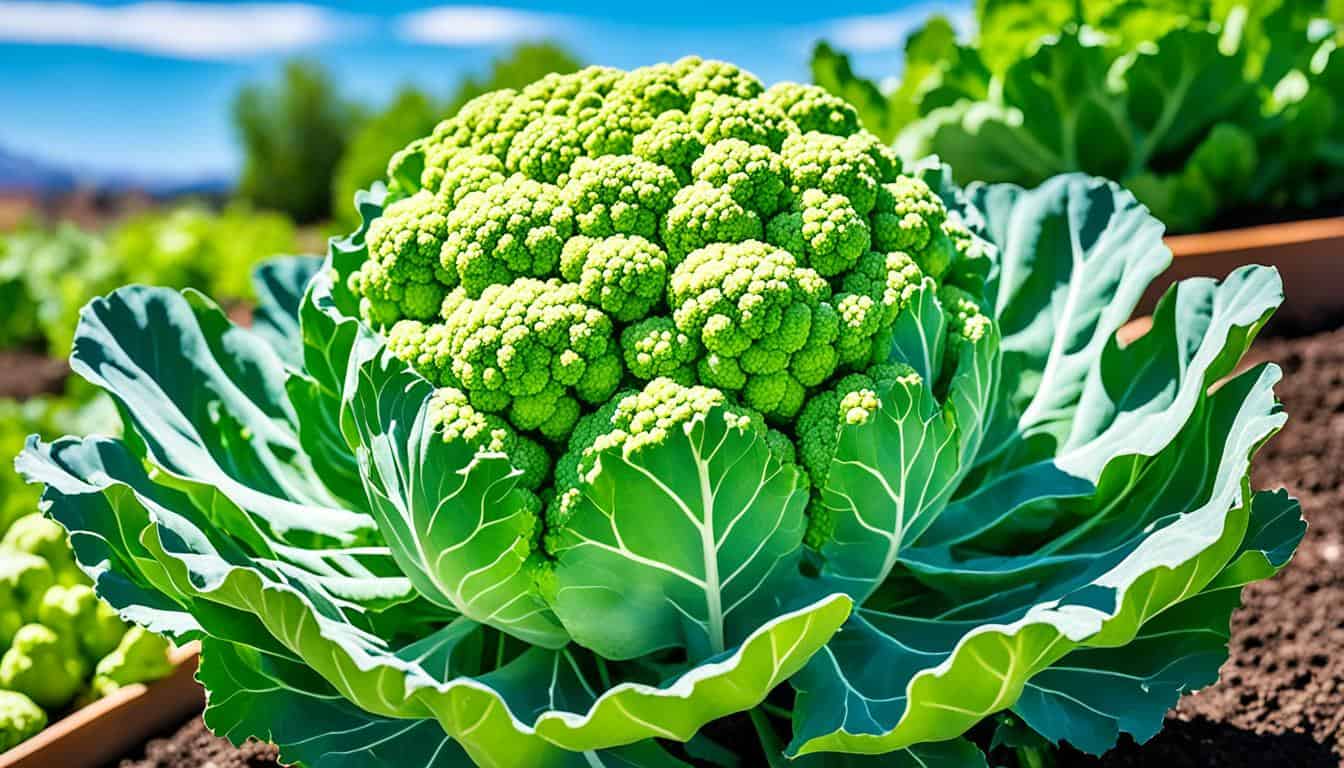
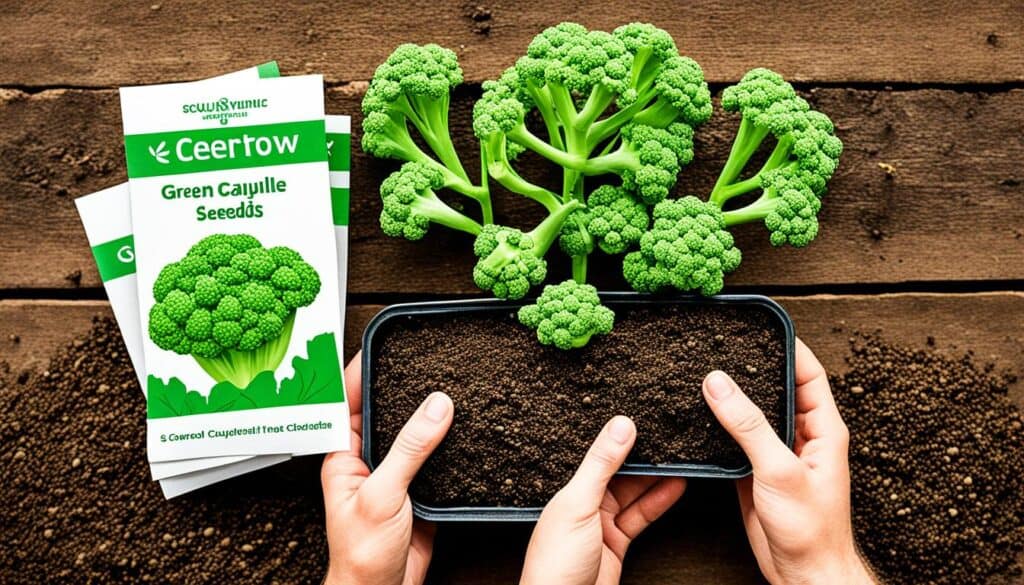
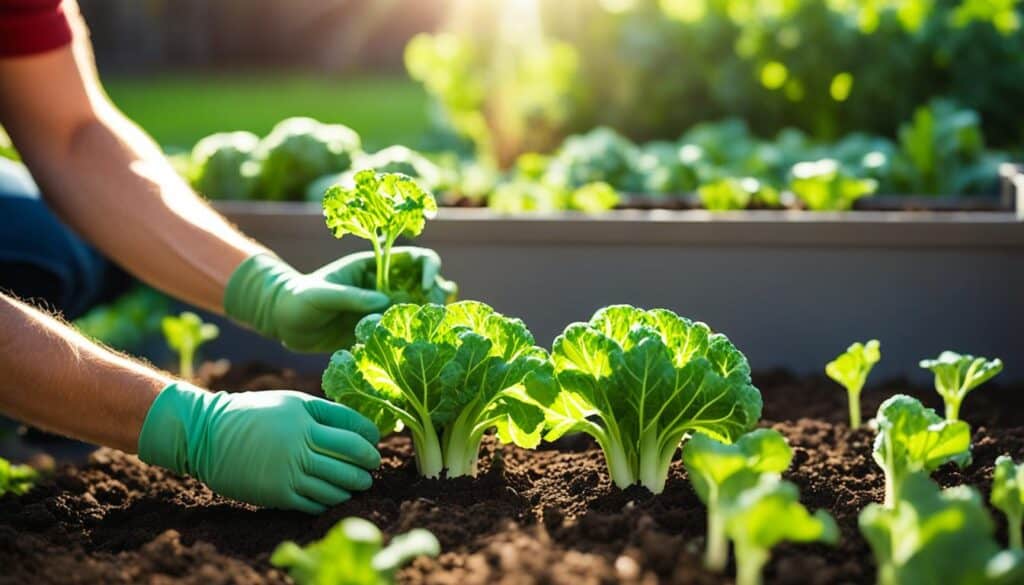
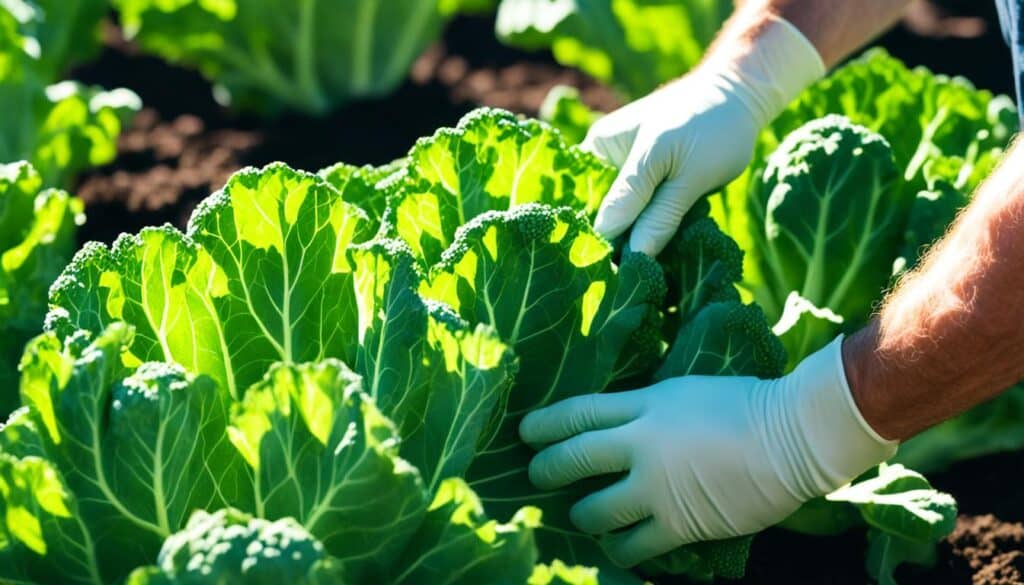
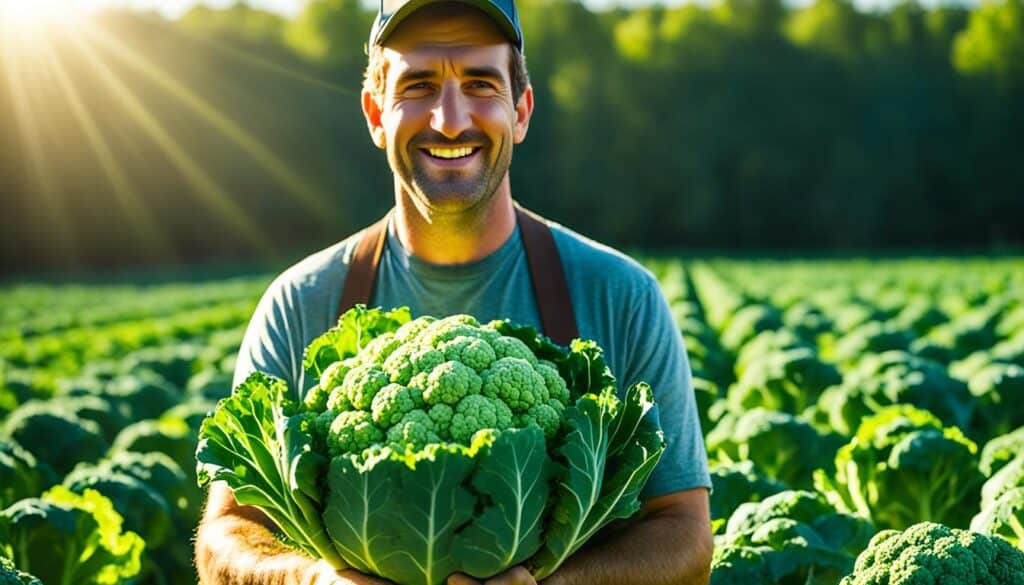
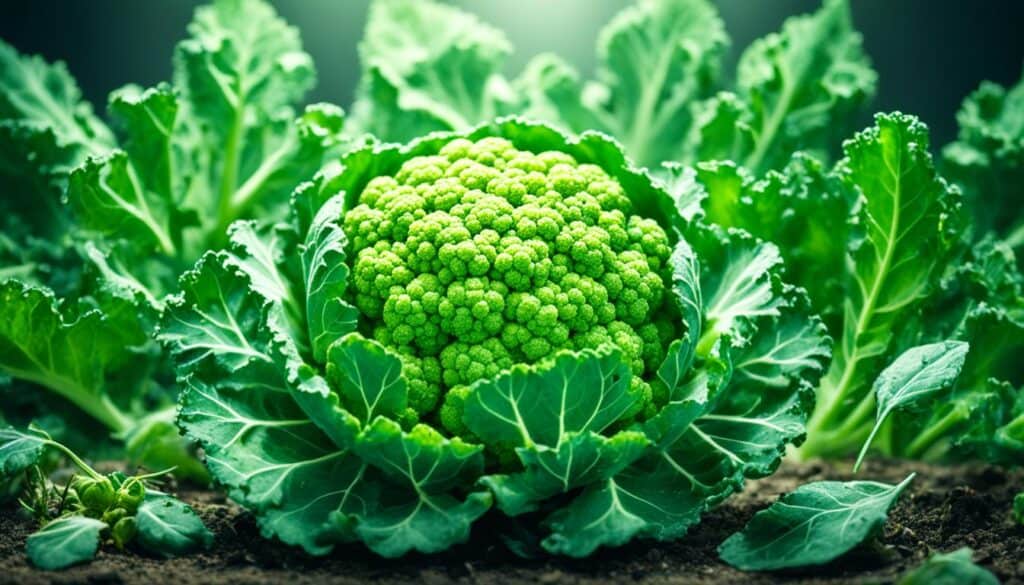



Leave a Reply